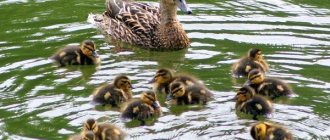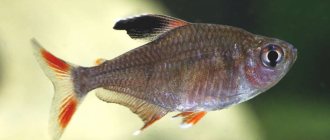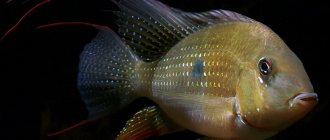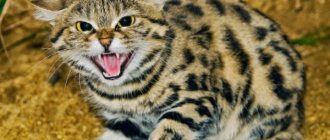09.19.2020 Scientist cat Animals The most common and numerous bird in Russia is the duck. This small-sized waterfowl lives in almost all fresh water bodies and slightly salted seas. Of all the ducks, the mallard has spread the most. This bird can be found everywhere in Russia.
All representatives of ducks have a wide, streamlined body. The beak is flattened and the feet are webbed. The neck is long and flexible. The plumage is dense, impenetrable to water. The layer of subcutaneous fat is well developed.
Migratory and sedentary species of ducks
Many species of wild ducks that do not fly away for the winter choose warm climate zones for permanent residence. The mallard is a migratory duck that prefers to live on rivers. But not all mallards migrate; there are also birds that lead a sedentary lifestyle.
Birds fly in small flocks. Pairs form in the fall or already during the winter, if individuals spend the winter together. The final formation of a pair occurs in the spring during nesting.
There are dozens of species of geese and ducks inhabiting Russian open spaces. Ducks belong to the order Anseriformes. They migrate to warmer regions for the winter: pintail, mandarin duck, mallard, teal, shelduck, killer whale, ogre, etc.
Reproduction
The mating season for all breeds begins at different times, depending on climatic conditions. Wild ducks immediately begin the breeding season upon returning to their native places. In species that do not migrate, the mating season begins at a favorable time, when the amount of food increases. Most often this is the period from April to May. It is not uncommon for a couple to form for a season. But, for example, tangerines form a pair for life.
Males at this time put on colorful breeding outfits. They actively court the female and organize peculiar rituals. Each variety is special. Some spread their crests and make unusual beautiful sounds. Others dance on the water, flap their wings and create a wall of spray. Still others organize races on the water surface. Sometimes females are the first to show signs of attention.
Breeds of domestic ducks
Meat and ornamental types of ducks are usually kept on the plot. The first species is represented by the domesticated mallard and musky duck. One comes from Russia, the second is a typical representative of the American continent.
Breeding and domestication of ducks began a long time ago, several thousand years ago. So all representatives of numerous modern species belong to these two breeds.
The Bashkir colored duck is considered the best in Russia; it is slightly larger in size and weight than the mallard. The Indian Runner is a small species of duck that has a peculiar posture and resembles a penguin. The turkey duck, or musk duck, has skin growths on its head, like a turkey.
Types of domestic ducks include ornamental representatives. They are kept solely for beauty and are not used for food. Cape teal, mandarin ducks and Carolina ducks are very bright and beautiful birds.
The mandarin duck's original habitat is East Asia. It flies to nesting grounds in the Amur and Sakhalin regions, Khabarovsk Territory and Primorye. She fell in love with mountain rivers and adjacent forests. It is a good swimmer, flies quickly and maneuverably. It is prohibited to hunt the mandarin duck; it is listed in the Red Book.
Representatives of meat breeds
Peking duck is the best representative of the meat breed. The breed was developed by Chinese poultry farmers more than 300 years ago in the foothills of Beijing. Gradually the breed spread throughout the world.
Large head, short and thick legs, long body, slightly raised. The neck is not very long, the wings fit tightly to the body. The plumage of the Peking duck is white-yellowish with a cream tint. This species quickly fattens and gains weight. Hardy, strong and tolerate severe cold well.
The Ukrainian breed has well-developed muscles and a thin bone skeleton. The plumage is dense, the color is gray, white and reddish. They develop quickly and gain weight, and have normal egg production.
The Muscovy white duck is similar in body type to the Peking duck. The breed was bred in the Moscow region. The bird has a long neck, a protruding chest, a wide back and short legs. The plumage is snow-white without signs of yellowness.
The Muscovy duck is often dark in color with a few light feathers. It has fleshy red growths on its head, for which it is often called the warty duck. The body of the bird is large, massive, the neck is short. The birds got their name because of the special musky smell that their skin and feathers emit. Ducks are undemanding to feed, hardy and not susceptible to disease. Gain weight quickly.
Mergansers
The merganser duck differs from other species in having a narrow beak ending in a claw curved towards the bottom. Along the edges of the beak there are pointed horny teeth.
Great merganser
This species lives in the forest zone. Weight reaches two kilograms. The head has elongated feathers, forming a wide double crest in the female. The “mirrors” are white, the beak is red, the legs are orange. In summer, the male can be distinguished by the white feathers on his wings. When a flying bird flaps its wings, it makes a sound similar to a whistle.
Medium merganser
For habitat it chooses the northern parts of the forest zone. Weighs about a kilogram. The beak is red, the legs are reddish-orange. There is a developed double crest on the back of the head. In summer, males have a dark back.
Scaly-sided merganser
A rare species found only in the south of the Far East. Externally similar to the average merganser. It is distinguished by its smaller size, gray beak and wide crest, more developed in females. In summer, the male has white spots on the back of his head.
Wild ducks inhabiting Russia
Birds of the Duck family live throughout Russia. Their range has spread from the northernmost latitudes to Eastern Siberia. Many species of wild ducks are hunted.
The most common trophy is the mallard. Mobile, quickly hides under water if it senses danger. Pintail, on the contrary, quickly rises from the water and flies away, which arouses great interest among hunters.
Species of wild ducks in Russia that live in nature are divided into two groups. The first includes: mallard, shoveler, pintail, wigeon, teal, etc. They feed in shallow water and spend a lot of time on river islands and meadows. These birds can be found in oak forests, where whole acorns serve as food. The common name for this species is dabbling ducks. Birds have a clearly visible tail. Dabbling ducks differ in body shape from diving ducks.
Mallard - standard duck
These are the most numerous representatives of river wild ducks. A favorite trophy of hunters. It is represented in the world by 12 species, but the mallard is the most famous among them.
The appearance of the duck can be taken as a standard. Compared to others, these types of ducks have a more streamlined body shape and a shorter neck. The beak is flattened, with tiny teeth on the sides, through which the bird filters water to feed on small plankton and living creatures.
The wings are powerful, but not long, which indicates the duck’s good flying abilities. The tail is slightly narrowed on the sides, short and as if cut off at the tip. The paws are set back a little and are short. The mallard has a well-developed coccygeal gland, which is responsible for the water-repellent properties of its plumage.
The bird's body reaches a length of 40–60 cm. The weight of the duck is up to 1 kg, the drake is not much larger in weight than the female. But the plumage and coloring of the male are clearly pronounced. The female mallard has a modest color, in which brownish-red tones predominate. Along the edge, each feather has a whitish border, this gives a flowing pattern to its body.
The drake has no streaks at all or only in small areas. The main color is brown, gray and black. The head and neck are dark green in color and glow violet-blue in the sun. The bird's feet are bright orange.
The mallard's range is the most extensive. They chose the shores of fresh water bodies, which were overgrown with dense reeds, reeds and bushes. Ducks get used to the presence of humans and settle in the city limits on ponds and canals.
Species of ducks in Russia that live in the north are migratory. Mallards from Eastern Europe leave the northern part of the country from early September to mid-October, heading to northern Africa and Asia Minor. Ducks from Siberia head to China for the winter.
During migration and wintering, flocks numbering thousands of birds are formed, but when they return back to the nesting sites, they break up into small flocks of 10–15 ducks.
Variety of teals
The birds owe their name to the characteristic sounds they make. Adult ducks can be about 40 cm in length, while drakes are larger and have brightly colored feathers. The mating colors can only be seen during the breeding season. Once this time has passed, the drakes become gray and inconspicuous, like their ducks.
Teal whistlers
The drake has a green stripe that starts in the eye area and ends at the back of the head. During the mating season, drakes are able to dance for several hours near their chosen ones, performing intricate movements both in the air and on the ground.
Teals
The main difference is the white stripe that adorns the bird's head. The species is characterized by very noisy mating games.
Teal-kloktunks
Can be considered the most noble representative of teal. In our country, these ducks are rare guests, which is why they are highly valued by hunters as a trophy. Nests are built in the northern regions of Asia and Sakhalin. Drakes can be distinguished by the characteristic emerald-golden feathers on their heads.
Marbled teals
These birds are smaller in size than kloktuns. An adult weighs about 0.6 kg. The plumage of drakes and ducks is practically indistinguishable. In our country, birds can be found in the Caspian region and in the Volga delta. Today the species is very rare; they were last described more than 33 years ago. The character of ducks is trusting and fearless. They spend almost their entire lives in water; the birds swim and dive beautifully. The population is declining due to the destruction of its natural habitat - small bodies of water with a large number of plants.
Merganser
Representatives of the breed are characterized by a cylindrical beak, along its edges there are small, but very sharp teeth. Thanks to their elongated body and neck, ducks become similar to loons and grebes.
Large mergansers
Most often, birds settle in forests. Grown drakes reach a length of more than half a meter, ducks are somewhat smaller. The weight of an adult is over 1.5 kg. The beak is red and the paws are orange. As summer approaches, drakes begin to develop white feathers next to their wings. You can distinguish a duck from another species thanks to the forelock growing on its head.
Medium-sized mergansers
They inhabit northern forest zones. The body length of drakes is more than 60 cm, and that of ducks is more than 55. Adult birds gain weight of about 1000 grams. The coloring of the paws and beak is identical to that of large mergansers. The back of the head is decorated with a well-developed crest. As summer approaches, drakes grow black feathers next to their wings, creating a wedding pattern that attracts ducks.
Scaly mergansers
They are among the rarest representatives of this breed. Sometimes birds can be seen in the Far East region. The color of the feathers coincides with the average mergansers, the difference lies in the size. Scaly representatives have a body length of about 40 cm and a weight of 0.5 kg. Ducks, unlike drakes, wear a large crest on their heads.
Pintail
It is one of the most common birds in our country. Can be found everywhere except in the southern and northern regions. Drakes have a large build and can reach a length of more than 60 cm, ducks are somewhat smaller - from 50 cm. The average weight is about 1000 grams. Compared to other ducks, they have a long, thin neck and sharp tail feathers.
By the onset of the mating season, the drakes remain the same color as they were, the color of the feathers practically does not change. They prefer to graze in dense coastal grasses.
Shoes
Can be found everywhere except the tundra. The bird is of medium size with a body length of 50 cm and a weight of 1000 grams. A distinctive feature is the beak of unusual width. Ducks spend a lot of time in ponds; they use grass, aquatic plants, and small insects for food. Drakes have black beaks, while ducks have brown-green beaks.
rump ducks
They are large wild ducks that gain a kilogram in weight and are capable of growing up to 50 cm. Females have a dark chocolate coloration, similar to wigeons, with a gray beak as a distinctive feature. With the onset of the mating season, drakes become covered with bright feathers, against the background of which the females become lost in their modest color.
Drakes have dark green plumage on the head, sides and collar. White feathers grow on the neck, and a bronze and white feather can be seen on the top of the head.
Their distribution range is quite wide; due to their appearance, they are often bred in private backyards. It prefers to nest in eastern Asia, northern Japan, the Kuril Islands, and the central zone of our country. Red-tailed ducks prefer wet meadows, plains and fresh water bodies.
Being in constant motion, they weigh little, but hunters still hunt them with pleasure.
Wild ducks have always been a favorite object of hunting. The meat of this bird is tasty and nutritious, and it can be found in almost any body of water.
In order for the hunt to be successful, you need to have a good knowledge of the habits and characteristics that distinguish the varieties of wild ducks.
Diving ducks
Representatives of the second group are diving ducks. They need to dive to the depths, helping themselves with their paws, since these birds have to get food at the bottom. Diving species of ducks in Russia: red-crested pochard, red-headed pochard, tufted duck, goldeneye.
This is a large group of birds that inhabits a vast territory of Russia. They live and nest on sea coasts. In winter they migrate to warm climate zones. Species of diving ducks are represented by birds of fairly large weight, which have a massive build and short legs. They are excellent swimmers and divers and can stay underwater for up to 3 minutes.
Nutrition
The diet of birds depends on their species. Nutrition affects the structure and abilities of ducks. Birds mainly find food in water. The diet includes both plant and animal foods, but their ratio is different. In breeds that feed exclusively on plant fibers, the tip of the beak is widened and has developed horny plates. If food of animal origin predominates, then the horny plates are pointed, which makes it possible to firmly hold the prey in the beak.
Common foods for ducks include fish, insects, crustaceans and shellfish, and algae. Some species are able to dive under water for long periods of time, which simplifies the hunting process. Birds that live in temperate latitudes and do not migrate switch to plant food in winter. Ducks have earned the nickname “water orderlies” due to the fact that they ingest large quantities of larvae, thereby reducing the population of insects, especially mosquitoes.
turn black
Representative of the genus Anatidae. Refers to diving ducks. It has a short neck and large head. These are small and stocky species of ducks. The photo and name of the duck can be easily identified. The collared duck has a black head and neck, as if it were wearing a collar. The red-headed duck has a bright red, almost copper color, head color. He can be easily recognized.
The duck spends a lot of time on the water. If it is necessary to get food from the bottom, it dives completely or partially, leaving the back of the body on the surface of the water.
Diving species of ducks can be easily distinguished from river ducks by their silhouette. The former have a lower stance and keep their tail lowered. To take off, they need a short run, but river ones can take off almost vertically. Blackheads rarely come onto land.
There are 5 species of ducks that live and nest in Russia. Tufted ducks, red-headed pochards, and buffalo pochards live in the European territory of the country up to Primorye.
River species
The river variety of ducks is distinguished by its high position in the water and its tail raised above the water. In search of food, they do not dive, but only submerge halfway in the water, leaving their tail above the surface of the water. They take off almost vertically, without a run-up. In flight, the difference from diving is especially noticeable due to the longer neck, tail and wings. They rarely stay in pack formation.
Shoveler
It is distinguished by an expanded spade-shaped beak. It flies somewhat awkwardly and slowly, slightly tilting its head down. Drakes are very beautiful: against the background of a white chest, a dark green head and neck stand out, and the sides and belly are red. Blue wings in front and a bright green “mirror”. Females are reddish-brown. The birds' feet are bright orange. They are considered the most carefree of river species.
Mallard
The wild mallard duck is familiar to all hunters; it is the largest river species. In spring, the drake has an emerald green head, white collar, brown chest and gray body. The male is lighter than the female. The mallard's legs are orange and its beak is yellow. Males have a longer neck and hold their heads high.
Black mallard
Habitat: the south of the Far East and Siberia. They are no different in size from the common mallard. Its peculiarity is that drakes do not differ from females, since they do not have mating colors. They are distinguished by black beaks with yellow spots on the top. In flight, white spots on the wings are clearly visible.
Pintail
Quite a large duck, males larger than females, with a long neck and an awl-like tail, which is why the bird got its name. The back and head are brown. The rest of the neck, crop and underparts are bright white. The female is gray.
Teal-whistle
The teal duck is the smallest among river ducks. The male has a brownish-red head with a wide green stripe from the eyes to the back of the head. The female is gray. At dusk, the male can be distinguished by a white stripe on the shoulder and a whitish section of the tail between the end of the tail and the abdomen.
Teal
This species lives in the forest belt. Both the drake and the female have large “mirrors” of green color, more pronounced in males. In summer, the male differs from the female by the gray-blue tops of his wings and shoulders.
Marbled or narrow-nosed teal
Habitat: Central Asia and the coast of the Caspian Sea. Average weight 500 gr. The plumage is gray-brown, lighter on the abdomen, the same in females and males. The beak is gray, the legs are brownish-brown. The male is distinguished by a small tuft on the back of his head and light spots around the eyes. They often sit on the branches of bushes and trees growing near water, unlike other types of teal.
Gray duck
The bird is larger than teal, grayish in color. The male differs from the female in having bluish wings and lighter plumage. The male's mating plumage: reddish head, white stripe from the eyes to the back of the head. The female has a rather long beak with a white spot on the side. In the dark, a drake can be distinguished from a female by frequently raising its head along with a cracking sound.
Wigeon
The bird is medium in size, distinguished by its bright white belly and short beak. The drake's head is reddish, its forehead is yellowish-golden, and its chest is chestnut-red. The female wigeon is very similar to the gray duck, differing from it in the dark brown “mirrors” on the wings.
The drake makes sharp sounds similar to a whistle, and the female’s voice is similar to a croak.
killer whale
Habitat: Far East, Eastern Siberia and Kamchatka. Average weight – 800 gr. The killer whale has a black beak and gray legs with dark membranes. The female is similar to a mallard duck, differing in the color of her legs and beak. The male retains bright “mirrors” on his wings even in summer. The voice is somewhat reminiscent of the whistling of a curlew.











